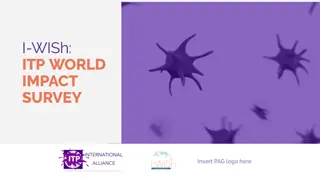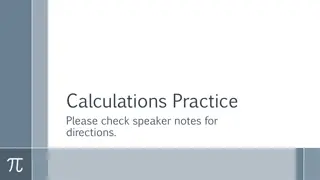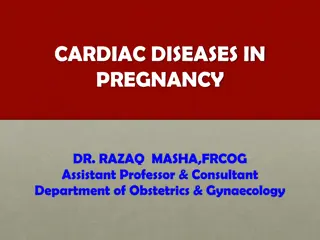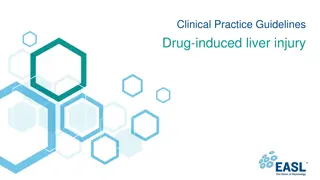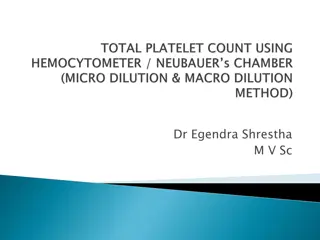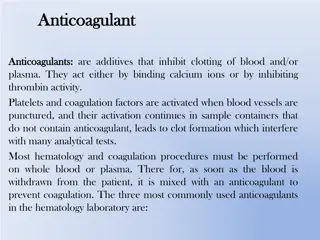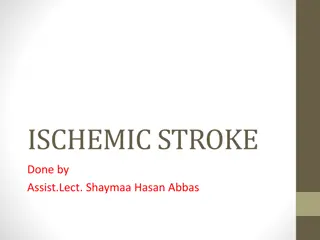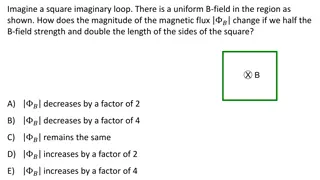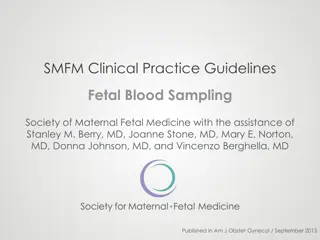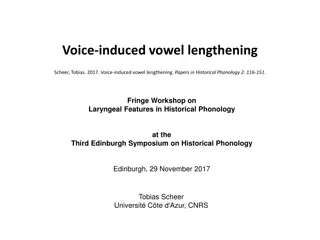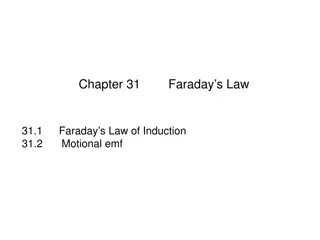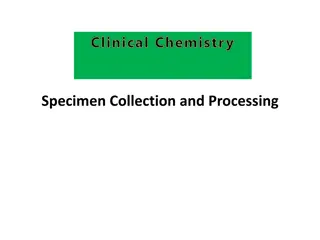Guidelines for Managing Heparin-Induced Thrombocytopenia by the American
Learn how the American Society of Hematology 2018 guidelines cover the diagnosis and management of heparin-induced thrombocytopenia (HIT), including details on the formation and development of these guidelines. Discover the clinical recommendations provided by experts, based on a comprehensive review of relevant evidence and key criteria.
Download Presentation

Please find below an Image/Link to download the presentation.
The content on the website is provided AS IS for your information and personal use only. It may not be sold, licensed, or shared on other websites without obtaining consent from the author.If you encounter any issues during the download, it is possible that the publisher has removed the file from their server.
You are allowed to download the files provided on this website for personal or commercial use, subject to the condition that they are used lawfully. All files are the property of their respective owners.
The content on the website is provided AS IS for your information and personal use only. It may not be sold, licensed, or shared on other websites without obtaining consent from the author.
E N D
Presentation Transcript
Diagnosis & Management Diagnosis & Management of Heparin of Heparin- -Induced Thrombocytopenia Induced Thrombocytopenia An Educational Slide Set American Society of Hematology 2018 Guidelines for Management of Venous Thromboembolism Slide set authors: Eric Tseng MD MScCH, University of Toronto Adam Cuker MD MS, University of Pennsylvania
Clinical Guidelines Clinical Guidelines American Society of Hematology 2018 guidelines for management of venous thromboembolism: heparin- induced thrombocytopenia Adam Cuker, Gowthami M. Arepally, Beng H. Chong, Douglas B. Cines, Andreas Greinacher, Yves Gruel, Lori A. Linkins, Stephen B. Rodner, Sixten Selleng, Theodore E. Warkentin, Ashleigh Wex, Reem A. Mustafa, Rebecca L. Morgan, and Nancy Santesso
ASH Clinical Practice Guidelines on VTE ASH Clinical Practice Guidelines on VTE 1. Prevention of VTE in Surgical Hospitalized Patients 2. Prevention of VTE in Medical Hospitalized Patients 3. Treatment of Acute VTE (DVT and PE) 4. Optimal Management of Anticoagulation Therapy 5. Prevention and Treatment of VTE in Patients with Cancer 6. Heparin-Induced Thrombocytopenia (HIT) 7. Thrombophilia 8. Pediatric VTE 9. VTE in the Context of Pregnancy 10. Diagnosis of VTE
How were these ASH guidelines developed? How were these ASH guidelines developed? PANEL FORMATION Each guideline panel was formed following these key criteria: Balance of expertise (including disciplines beyond hematology, and patients) Close attention to minimization and management of conflicts of interest CLINICAL QUESTIONS 10 to 20 clinically- relevant questions generated in PICO format (population, intervention, comparison, outcome) EVIDENCE SYNTHESIS Evidence summary generated for each PICO question via systematic review of health effects plus: Resource use Feasibility Acceptability Equity Patient values and preferences MAKING RECOMMENDATIONS Recommendations made by guideline panel members based on evidence for all factors. Example: PICO question In patients with suspected HIT and an intermediate probability 4Ts score, should non-heparin anticoagulants be provided at therapeutic or prophylactic intensity?
How patients and clinicians should use these recommendations How patients and clinicians should use these recommendations STRONG Recommendation ( The panel recommends ) CONDITIONAL Recommendation ( The panel suggests ) Most individuals would want the intervention. A majority would want the intervention, but many would not. For patients Different choices will be appropriate for different patients, depending on their values and preferences. Use shared decision making. Most individuals should receive the intervention. For clinicians
Objectives Objectives By the end of this module, you should be able to 1. Describe a diagnostic algorithm for patients with suspected heparin-induced thrombocytopenia (HIT) 2. Compare non-heparin anticoagulants for the treatment of acute HIT 3. Describe recommendations for managing anticoagulation for cardiac surgery in patients with a previous history of HIT
HIT is a profoundly hypercoagulable state HIT is a profoundly hypercoagulable state These antibodies cause a hypercoagulable state by activating platelets and procoagulant microparticles HIT is an iatrogenic disorder usually mediated by IgG antibodies that bind PF4-heparin complexes One-third to one-half of patients with HIT develop venous, arterial, or microvascular thrombosis Unfractionated heparin (UFH) associated with 10-fold increase in risk of HIT compared with LMWH
Case 1: Medical Inpatient Admission Case 1: Medical Inpatient Admission 82 year old male Past Medical History: Diabetes, hypertension, congestive heart failure Medications: Metformin, ramipril, aspirin, furosemide Admitted to: Internal Medicine ward with exacerbation of congestive heart failure, secondary to poor compliance with diet and diuretics Treated with: Intravenous furosemide, nitroglycerin patch Subcutaneous unfractionated heparin (UFH) 5,000 IU Q12H started on admission date for DVT prophylaxis
Case 1: Medical Inpatient Admission Case 1: Medical Inpatient Admission Bloodwork: Day 0 is admission date No fever, no other new medications. Normal blood pressure and heart rate. No signs or symptoms of venous thromboembolism. No bleeding or bruising No exposure to heparin in the 3 months prior to this admission +5 +7 +1 +2 +3 +4 +6 Date Day 0 Platelets (x 109) 230 67 220 206 210 220 150 200
Considering your patients progressive thrombocytopenia and heparin exposure, you are concerned about the possibility of HIT. Which of the following most accurately describes his clinical probability of HIT? A. Probably low probability, given overall clinical context B. Probably high probability, given overall clinical context C. Low probability, based on 4Ts score D. Intermediate probability, based on 4Ts score E. High probability, based on 4Ts score
Recommendation Recommendation In patients with suspected HIT, the panel recommends using the 4Ts score to estimate the probability of HIT rather than a gestalt approach(strong recommendation, moderate certainty) Remarks: Missing or inaccurate information may lead to a faulty 4Ts score and inappropriate management Every effort should be made to obtain accurate and complete information necessary to calculate the 4Ts score. If key information is missing it may be prudent to err on the side of a higher 4Ts score. Reassess frequently. If there is a change in clinical picture, the 4Ts score should be recalculated.
The 4Ts Score: Clinical Probability The 4Ts Score: Clinical Probability Model Model Our patient: Platelets 67, > 50% drop. Onset of drop on day +6. No thrombosis. No other cause for thrombocytopenia. HIGH probability: 6-8 points INTERMEDIATE probability: 4-5 points LOW probability: 3 points Lo J Thromb Haemost 2006 ASH 2009 Clinical Guide
Your patients 4Ts score indicates a high clinical probability for HIT. What diagnostic tests would you recommend at this point to confirm or exclude a diagnosis of HIT? A. None; patient is high probability and diagnosis is confirmed B. Immunoassay only (ex. HIT PF4/heparin ELISA) C. Functional test only (ex. serotonin release assay) D. Immunoassay, and if positive then perform functional test
Laboratory Diagnostic Testing for HIT Laboratory Diagnostic Testing for HIT HIT Immunoassay Tests Detect the presence of anti-PF4/heparin antibodies ELISA (detect IgG) ELISA (detect polyspecific antibodies) IgG-specific chemiluminescent assay Particle gel immunoassay (PaGIA) Latex agglutination assay Functional HIT Assays Assays that detect antibodies capable of binding and activating platelets Serotonin release assay (SRA) Heparin-induced platelet activation test (HIPA) Platelet aggregation test (PAT) Flow cytometry-based assays
Recommendation Recommendation If there is an intermediate- or high-probability 4Ts score, the panel recommends an immunoassay (strong recommendation, moderate certainty) If the immunoassay is positive and a functional assay is available (locally or as a send-out test to a reference laboratory), the panel suggests a functional assay(conditional recommendation, moderate certainty) Remark: Likelihood of HIT increases with a higher 4Ts score and a higher ELISA OD (Optical Density)
A diagnostic algorithm of intermediate/high 4Ts score, followed by immunoassay, followed by functional testing results in: Few false negatives (missed HIT diagnoses), and Few or no false positives (incorrect diagnoses of HIT) A functional assay may not be necessary for patients with high probability 4Ts score and very strongly positive immunoassay (ELISA value of > 2.0 OD units)
Your patients 4Ts score indicates high probability for HIT, and you have sent off the HIT ELISA (result is pending). Currently, your patient is receiving subcutaneous UFH 5,000 units twice daily. What management strategy would you recommend while awaiting the HIT ELISA test results? A. Continue heparin as the diagnosis of HIT is not confirmed B. Stop heparin, wait for ELISA result C. Stop heparin, start non-heparin anticoagulant at prophylactic intensity D. Stop heparin, start non-heparin anticoagulant at therapeutic intensity E. Stop heparin, transfuse platelets
Recommendation Recommendation In patients with suspected HIT and HIGH PROBABILITY 4Ts score: The panel recommends discontinuation of heparin and initiation of a non-heparin anticoagulant at therapeutic intensity(strong recommendation, moderate certainty) In patients with suspected HIT and INTERMEDIATE PROBABILITY 4Ts score: The panel recommends discontinuation of heparin (strong recommendation, moderate certainty) The panel suggests initiation of non-heparin anticoagulant at prophylactic intensity if patient is at high bleeding risk, therapeutic intensity if patient not at high bleeding risk In patients with INTERMEDIATE-risk 4Ts score who have high bleeding risk, there could be greater harm with therapeutic-intensity treatment (bleeding) with less potential benefit, because fewer such patients will have HIT
Therapeutic versus Prophylactic Intensity Therapeutic versus Prophylactic Intensity Non-heparin anticoagulant at therapeutic intensity is recommended over prophylactic intensity based on very low certainty of evidence 3 small studies comparing therapeutic versus prophylactic anticoagulation with Danaparoid, Lepirudin, or Fondaparinux Danaparoid showed 50% reduction in thrombosis with therapeutic dosing No difference in outcomes with Lepirudin and Fondaprainux However, strong recommendation based on likely large magnitude of benefit (prevention of thrombosis) Schindewolf Thromb Res 2012 Greinacher A Circulation 1999 Farner Thromb Haemost 2001
Recommendation Recommendation In patients with HIT who are at average bleeding risk, the panel suggests against routine platelet transfusion(conditional recommendation, low certainty) Remark: Platelet transfusion may be an option for patients with active bleeding or at high bleeding risk Low certainty for beneficial or adverse effects of platelet transfusions in HIT Mixed results from observational studies One large database study (n = 6,332) suggested increase in arterial thrombotic events (adjusted odds ratio 3.4, 95% CI 1.2 to 9.5); other small cohort studies suggest no difference Goel Blood 2015 Refaai J Thromb Haemost 2010
Case 1: HIT Laboratory Test Results Case 1: HIT Laboratory Test Results Your HIT immunoassay (ELISA) results are reported back that afternoon as optical density (OD) = 1.8 (NORMAL OD is < 0.4 at your lab). You ask your lab to send a sample to your local reference lab for a confirmatory functional assay (serotonin release assay). Your patient continues to be clinically stable with no symptoms or signs of pulmonary embolism, deep vein thrombosis, or arterial thrombosis.
Your patient has acute isolated HIT (without thrombosis), and platelet count is currently 67. Which of the following non-heparin anticoagulants would NOT be appropriate at this point? A. Argatroban B. Warfarin (vitamin K antagonist) C. Rivaroxaban D. Fondaparinux E. Danaparoid
Recommendation Recommendation In patients with acute HITT or acute isolated HIT, the panel recommends against initiation of a VKA prior to platelet count recovery(platelets 150 x 109/L) (strong recommendation, moderate certainty) Remarks: Also applies to those taking VKA at onset of acute HITT or acute isolated HIT In these patients, VKA would be discontinued and intravenous Vitamin K administered concomitant with initiation of a non-heparin anticoagulant In case series, early initiation of VKA associated: Warfarin-induced skin necrosis Venous limb gangrene Recurrent thrombosis Limb amputation
Recommendation Recommendation In patients with acute HIT complicated by thrombosis (HITT) or acute HIT without thrombosis (isolated HIT), the panel recommendsdiscontinuation of heparin and initiation of a non-heparin anticoagulant (strong recommendation, moderate certainty) The panel suggests argatroban, bivalirudin, danaparoid, fondaparinux or a direct oral anticoagulant (DOAC)
Rationale for Anticoagulant Selection Rationale for Anticoagulant Selection Using a non-heparin anticoagulant (compared with stopping heparin +/- starting VKA) associated with: Fewer thrombotic events BUT probably increase in risk of major bleeding No direct comparisons of DOACs vs. parenteral anticoagulants in HIT Small numbers of patients treated with DOACs in case series Few thrombotic events (rivaroxaban 1/46, apixaban 0/12, dabigatran 1/11) Benefits and harms of DOACs compare favorably to parenteral agents
Rationale for Anticoagulant Selection Rationale for Anticoagulant Selection Clinical Context Implications for Anticoagulant Selection Critical illness Increased bleeding risk Possible urgent procedures Argatroban or Bivalirudin (shorter duration of effect) If moderate or severe hepatic dysfunction (Childs-Pugh B or C), may be advisable to avoid argatroban or use a reduced dose Life- or limb-threatening VTE (massive PE or venous limb gangrene) Parenteral non-heparin anticoagulant preferred (Argatroban, Bivalirudin, Danaparoid, Fondaparinux) Few such patients treated with DOACs Clinically stable patients at average bleeding risk Fondaparinux or DOACs reasonable Most published DOAC experience with Rivaroxaban
Anticoagulant (mechanism, route) Dosing Clearance & Monitoring Bolus: None Infusion: STANDARD (2 mcg/kg/min), REDUCED DOSE for liver dysfunction, CHF, post-cardiac surgery (0.5-1.2 mcg/kg/min) Hepatobiliary clearance Adjusted to aPTT 1.5-3.0 times baseline Argatroban (direct thrombin inhibitor) IV Bolus: None Infusion: STANDARD (0.15 mg/kg/hr); consider REDUCED DOSE for renal or liver dysfunction Enzymatic clearance Adjusted to aPTT 1.5-2.5 times baseline Bivalirudin (direct thrombin inhibitor) IV Bolus: Weight-based (1500-3750 units) Infusion: INITIAL ACCELERATED (400 units/hr x 4 hr, then 300 units/hr x 4 hr), then MAINTENANCE (150-200 units/hr) Renal clearance Adjusted to anti-Xa activity 0.5-0.8 units/mL Danaparoid (indirect Xa inhibitor) IV < 50 kg 5 kg daily 50-100 kg 7.5 mg daily > 100 kg 10 mg daily Fondaparinux (indirect Xa inhibitor) SC Renal clearance No monitoring Rivaroxaban (direct Xa inhibitor) PO HITT:15 mg twice daily x 3 weeks, then 20 mg daily Isolated HIT:15 mg twice daily until platelet count recovery ( 150) Renal clearance No monitoring
Case 1: Treatment Case 1: Treatment You decide to start your patient on rivaroxaban 15 mg PO BID and discontinue subcutaneous UFH. Over the next 8 days, your patient s platelet count gradually rises from 67 to 165, and there is no evidence of bleeding.
Your patient has no symptoms of deep vein thrombosis or pulmonary embolism. Which of the following tests would you suggest to screen for asymptomatic VTE? A. There are no symptoms, so imaging is not indicated B. Bilateral upper extremity compression ultrasound (US) C. Bilateral lower extremity compression ultrasound (US) D. CT pulmonary angiogram E. Choices C & D
Recommendation Recommendation In patients with acute isolated HIT, the panel suggests: Ultrasound studies have identified silent lower extremity DVT in 12-44% of asymptomatic patients with HIT Bilateral lower extremity compression US to screen for asymptomatic proximal DVT (conditional recommendation, very low certainty) Upper-extremity US in patients with an upper extremity central venous catheter, in the limb with the catheter, to screen for asymptomatic DVT (conditional recommendation, very low certainty)
Case 1: HITT Case 1: HITT He is found to have an occlusive left popliteal vein DVT. He continues rivaroxaban 15 mg BID for 3 weeks, then takes rivaroxaban 20 mg daily for a total of 3 months. At 3 months, his platelet count is normal (205 x 109/L) and he is at his baseline health status. You ask him to stop rivaroxaban. 15 months later, he returns to hospital with CHF again and is found to have severe aortic stenosis, with an aortic valve area of 0.6 cm2. He requires a valve replacement.
Your patient with a history of HITT requires open heart surgery, with intraoperative anticoagulation while on pump. His platelet count is normal. You repeat his HIT ELISA and OD is 0.2 (NORMAL < 0.4). What would you suggest that your patient receive for intraoperative anticoagulation? A. Preoperative plasma exchange and intraoperative heparin B. Intraoperative heparin only C. Intraoperative heparin with an antiplatelet agent D. Intraoperative bivalirudin only E. Intraoperative bivalirudin with an antiplatelet agent
Five Phases of HIT Five Phases of HIT Phase Platelet count Immunoassay Functional assay Suspected HIT Decreased ? ? Acute HIT Decreased + + Subacute HIT A Normal + + Subacute HIT B Normal + Remote HIT Normal
Recommendation Recommendation In patients with subacute HIT B or remote HIT who require cardiovascular surgery, the panel suggests intraoperative anticoagulation with heparin rather than treatment with a non-heparin anticoagulant, plasma exchange and heparin, or heparin combined with antiplatelet agent (conditional recommendation, very low certainty) Remarks: Treatment with heparin would be limited to the intraoperative setting, and avoided before and after surgery Postoperative platelet count monitoring for HIT may be necessary, even when postoperative heparin is not given, because delayed-onset (autoimmune) HIT beginning 5 to 10 days after intraoperative heparin exposure has been reported
Case 2: Medical Inpatient Admission Case 2: Medical Inpatient Admission 82 year old male Past Medical History: Diabetes, hypertension, congestive heart failure Medications: Metformin, ramipril, aspirin, furosemide Admitted to: Internal Medicine ward with exacerbation of congestive heart failure, secondary to poor compliance with diet and diuretics Treated with: Intravenous furosemide, nitroglycerin patch Subcutaneous unfractionated heparin (UFH) 5,000 IU Q12H started on admission date for DVT prophylaxis
Case 2: Medical Inpatient Admission Case 2: Medical Inpatient Admission Bloodwork: Day 0 is admission date No fever, no other new medications. Normal blood pressure and heart rate. No signs or symptoms of venous thromboembolism No bruising or bleeding No exposures to heparin in the 3 months prior to this admission +5 +7 +1 +2 +3 +4 +6 Date Day 0 Platelets (x 109) 145 125 220 206 145 140 130 200
Considering your patients progressive thrombocytopenia and heparin exposure, you are concerned about the possibility of HIT. Which of the following most accurately describes his clinical probability of HIT? A. Probably low probability, given overall clinical context B. Probably high probability, given overall clinical context C. Low probability, based on 4Ts score D. Intermediate probability, based on 4Ts score E. High probability, based on 4Ts score
The 4Ts Score: Clinical The 4Ts Score: Clinical Probability Model Probability Model Our patient: Platelets 125, 30-50% drop Drop at Day +2 No thrombosis No other cause for thrombocytopenia HIGH probability: 6-8 points INTERMEDIATE probability: 4-5 points LOW probability: 3 points Lo J Thromb Haemost 2006 ASH 2009 Clinical Guide
Your patients 4Ts score (3) indicates a low clinical probability for HIT. What diagnostic tests would you recommend at this point to confirm or exclude a diagnosis of HIT? A. None; patient is low probability and HIT is highly unlikely B. Immunoassay only (ex. HIT PF4/heparin ELISA) C. Functional test only (ex. serotonin release assay) D. Immunoassay, and if positive then perform functional test
Recommendation Recommendation In patients with suspected HIT and low probability 4Ts score, the panel recommends against HIT laboratory testing (strong recommendation, moderate certainty) Remark: HIT laboratory testing may be appropriate for patients with a low probability 4Ts score if there is uncertainty about the 4Ts score (for example, due to missing data)
Case 2: Resolution Case 2: Resolution Given his low clinical probability, you elect not to send his HIT ELISA assay or functional assay. He continues to receive SC heparin. With treatment for CHF, his thrombocytopenia improves. He is discharged with a follow-up outpatient CBC to ensure resolution of thrombocytopenia +5 +7 +1 +2 +3 +4 +6 Date Day 0 Platelets (x 109) 145 125 220 206 145 140 130 200 +8 +9 +20 Date Platelets (x 109) 145 160 165
Additional Topics in these Guidelines Additional Topics in these Guidelines Platelet count monitoring in patients receiving heparin Prophylactic IVC filter insertion in the setting of acute HIT Duration of non-heparin anticoagulant therapy in acute isolated HIT Anticoagulant management for percutaneous coronary intervention in patients with acute HIT or previous history of HIT Anticoagulant therapy for HIT in renal replacement therapy
Areas of Future Investigation Areas of Future Investigation Development of novel HIT immunoassays and functional assays Outcomes from treatment of acute HIT with DOACs Comparisons of DOACs and parenteral non-heparin anticoagulants Role of concomitant antiplatelet and anticoagulant therapy in HIT Impact of screening for asymptomatic DVT in acute isolated HIT Optimal duration of anticoagulation in acute isolated HIT Intraoperative anticoagulant management for cardiovascular surgery
In Summary: Back to our Objectives In Summary: Back to our Objectives 1. Describe a diagnostic algorithm for patients with suspected heparin-induced thrombocytopenia (HIT) 4Ts score, immunoassay, functional assay 2. Compare non-heparin anticoagulants for treatment of acute HIT DOACs or parenteral options (Argatroban, Fondaparinux, Danaparoid, Bivalirudin) 3. Describe recommendations for managing anticoagulation for cardiac surgery in patients with a previous history of HIT Determination of HIT clinical status with ELISA and/or functional assay helps to determine intraoperative anticoagulation plan
Acknowledgements Acknowledgements ASH Guideline Panel team members Knowledge Synthesis team members McMaster University GRADE Centre Author of ASH VTE Slide Sets: Eric Tseng MD MScCH, University of Toronto and Adam Cuker MD MS, University of Pennsylvania See more about the ASH VTE guidelines at http://www.hematology.org/VTEguidelines Don t miss our updated HIT Pocket Guide!


